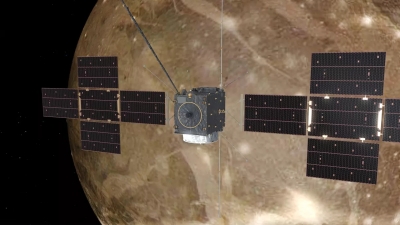ESA looking to fix antenna glitch on JUICE Jupiter probe
By IANS | Published: April 29, 2023 03:00 PM2023-04-29T15:00:03+5:302023-04-29T15:15:25+5:30
Paris, April 29 The European Space Agency's (ESA) Jupiter Icy moons Explorer or JUICE mission, which began its ...

ESA looking to fix antenna glitch on JUICE Jupiter probe
Paris, April 29 The European Space Agency's (ESA) Jupiter Icy moons Explorer or JUICE mission, which began its journey to Jupiter two weeks ago, has faced an issue with its antenna.
According to the agency, JUICE's ice-penetrating Radar for Icy Moons Exploration (RIME) antenna could not yet be deployed as planned.
"During the first week of commissioning, an issue arose with the 16-metre-long RIME antenna, which is preventing it from being released from its mounting bracket," the agency said in a statement.
Mission officials "continue" to work to "free the radar" and "they have lots of ideas up their sleeves", the ESA said.
JUICE is ESA's first-ever mission to find alien life on the icy worlds of Jupiter. It launched to the largest planet on April 13. The spacecraft will take an eight-year journey to reach in 2031.
The mission JUICE is otherwise "performing excellently after the successful deployment and operation of its mission-critical solar arrays and medium gain antenna, as well as its 10.6-m magnetometer boom", the ESA said.
Images from the Juice Monitoring Camera on board the spacecraft with a partial view of the radar and its mount shows more signs of movement in the RIME antenna.
It has now partially extended but still the radar is roughly a third of its full intended length.
The current leading hypothesis is that a tiny stuck pin has not yet made way for the antenna's release. In this case, it is thought that just a matter of millimetres could make the difference to set the rest of the radar free, the ESA said.
As per mission officials, various options are still available to nudge the important instrument out of its current position.
The next steps to fully deploy the antenna include an engine burn to shake the spacecraft a little followed by a series of rotations that will turn JUICE, warming up the mount and radar, which are currently in the cold shadows.
With two months of planned commissioning remaining, there is plenty of time for teams to get to the bottom of the RIME deployment issue and continue work on the rest of the powerful suite of instruments on their way to investigate the outer Solar System.
The RIME instrument is an ice-penetrating radar designed to study the surface and subsurface structure of Jupiter's icy moons down to a depth of 9 km.
It is one of ten instruments on board JUICE, set to investigate the emergence of habitable worlds around gas giants and the formation of our Solar System.
Disclaimer: This post has been auto-published from an agency feed without any modifications to the text and has not been reviewed by an editor
Open in app